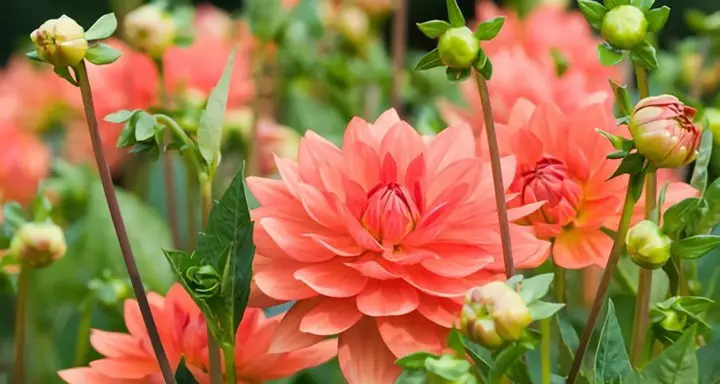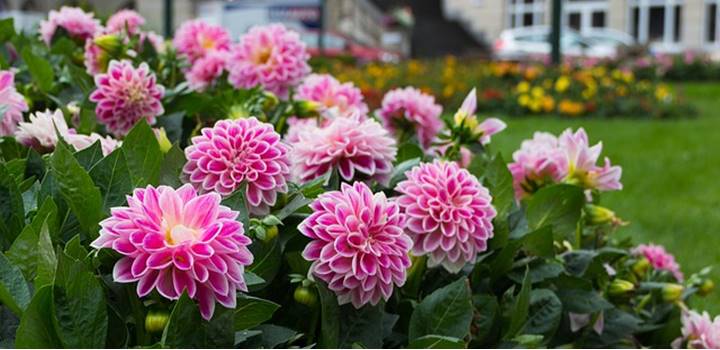Dahlias grow in a wide range of areas and are quite low maintenance. But they face some problems from time to time. One of them is wilting or drooping of leaves.
Incorrect watering, Soil problem, Excessive Sunlight, Pests and, Fungal problems are the main reasons for Dahlia leaves drooping.
The very first step of reviving the drooping leaves is identifying the problem and taking proper action.
In this article, I’ve described all the possible causes of Dahlia leaves drooping with their actionable solutions.
So let’s begin-
How to Fix Leaves Drooping Problem of Dahlia-Quick Guide
|
Reason |
Solution |
| Incorrect Watering | Improve the drainage and water the plant when the soil feels dry |
| Soil Problem | pH should be 6-6.5 in range. Apply acetic fertilizer |
| Excessive Sunlight | Use artificial shade to protect against direct sunlight |
| Pests | Spray Pyrethrins or Pyrethroids contain insecticide |
| Fungal Problems | Remove affected leaves and spray fungicide |
Causes and Treatment of Dahlia Leaves Drooping

1. Incorrect Watering
The most common reason for Dahlia leaves drooping is incorrect watering. Dahlias are tropical plants so they need enough water for their growth and stability. When they don’t get enough water, their leaves start drooping to reduce further moisture loss.
This also ends in drying up Dahlia leaves.
Over-watering can also cause the same problem. Roots cannot work properly in waterlogged conditions So it becomes unable to transport enough water and nutrients and results in Dahlia’s leaves wilting.
You can test the soil with a moisture meter(Our pick: Atree Soil Soil Tester Kits with Moisture, Light, and PH Test for Garden). You can also dip your finger or a stick into the soil to check if it’s dry or moist.
Control Measure
If the soil is soggy, don’t water until it dries out. And if the soil is dry then you can water it. Also, you can add organic mulch such as straw, bark chips, dry leaves, etc. These will help to keep the moisture in dry conditions.
If your potted Dahlias are over-watered. you can repot it with better-drained soil.
Make sure there are enough drainage holes in the pot. You can add sand or some perlite (our pick: Organic Perlite by Perfect Plants) to the soil mixture of your potted Dahlia to get better drainage
Watering depends on plant size, soil condition, and environmental conditions. Water your Dahlias 2 or 3 times a week in the dry season. You may not need watering if there’s frequent rain. If necessary you can do shallow watering if the soil seems dry.
2. Soil Problem
Excessive nutrients in the soil cause toxicity. A high concentration of any nutrient hampers plant roots. So plants cannot regulate water throughout their body properly. As a result, it produces floppy leaves in Dahlia.
To identify this problem you have to check the pH level of the soil. Dahlias prefer pH 6-6.5. High soil pH may result in nutrient toxicity.
Control Measure
You can lower the pH by using acidic fertilizers like Aluminum sulfate and Sulfur. (Our pick: Jobe’s Organics Soil Acidifier Fertilizer) Organic mulches can also be effective. Sometimes nutrient toxicity is induced by other nutrient deficiencies. So make sure you feed your plant the right amount of nutrients.
Nitrogen-Phosphorus-Potassium in a 5:10:10 ratio is best for Dahlia. Because this ratio indicates a low dosage of Nitrogen which is exactly what Dahlias need.
3. Excessive Sunlight
Dahlias require 5-6 hours of sunlight. Preferably in the morning. Long exposure to the bright sun can cause leaf problems of Dahlia like yellowing and wilting.
Ironically, if they don’t get enough sunlight they will still produce floppy leaves.
Control Measure
On hot summer days especially with scorching sun, remember to water them just enough to keep them hydrated. You can also cover the Dahlias with a piece of cloth to protect them from direct sunlight especially in high temperatures.
Preventive Measure
To prevent sun-burning you can move your potted Dahlias in shade during the afternoon. When planting in the garden or landscape you can select a place where Dahlias can get shade from intense sunlight by any buildings or trees.
4. Pests
Aphids, mites, root-knot nematodes play a big part in creating leaf problems like wilting and yellowing. Aphids and mites weaken the plant by sucking on the leaves and stems. Root-knot nematodes injure the roots so plants aren’t able to uptake sufficient water and nutrients.
Aphids and mites can be seen on the leaves of the plant if checked closely. But root-knot nematodes are too tiny to be seen by the naked eye. The only way to be sure of their presence is by physically seeing the root which will show bubble-like abnormal growth called ‘galls’.
Control Measure
Insecticides containing Pyrethrins or Pyrethroids (our pick: Garden Safe Brand Ready-to-Use Garden Insect Killer)are best to kill aphids and other insects as they are less toxic than other insecticides.
Neem oil, insecticidal soap, and horticultural oil are very effective against Dahlia’s insects. You can also spray cold water but it’s only effective to some extent. You can purchase some beneficial insects like ladybugs or lacewings to get rid of insects.
Some organic ways to kill insects are garlic spray and tomato leaf spray. You can also cover the plant, especially during early springs to protect from aphids.
If you notice the mite activities only, you can pick miticide. The best idea is to pick the triple-action pest control spray that can act as insecticide, miticide, and fungicide. (Our pick: Trifecta Crop Control Super Concentrate All-in-One Natural Pesticide, Fungicide, Miticide).
Also, you can prepare a homemade solution for killing insects and pests. Here is the two most effective homemade insect solution for your Dahlias-
#Tomato Leaf Spray Recipe
Chop a cup of tomato leaves and let them stay overnight in 250 ml of water. Then strain out all the leaves and add another 250 ml of water to dilute the solution. Spray on the infected leaves. Tomato leaves have alkaloids on them which are toxic to insects but completely safe to plants and humans.
#Horticultural Oil Spray Recipe
Take 250 ml of oil and 1 tablespoon of liquid soap and mix them very thoroughly. You can store it as a stock solution. Add half a tablespoon of the stock solution in 250 ml of water and pour it into your sprayer.
Preventive Measure
Avoid over-fertilization of nitrogen because aphids attack high nitrogenous leaves.
Nematodes attack when plants cannot get enough water. Add organic matter like manure and compost during soil preparation to help the soil retain moisture.
5. Fungal Problems
Root rot, stem rot and, verticillium wilt are some fungal problems that cause wilting of dahlia. Root and stem rots are mainly caused by fungi called Rhizoctonia and pythium. Reviving the wilted leaves is not easy in these cases.
When the root gets too much water it gets attacked by various fungi. And the root starts to rot along with the stem near the surface. verticillium fungi attack roots and injure the conductive tissues. As a result, roots cannot uptake enough water, and plants start to wilt.
Control Measure
Remove the infected plant or infected parts before they can do any further damage. Always disinfect garden tools with bleach. In the case of potted Dahlias, you can re-pot the infected ones in fresh soil.
There is no cure for Verticillium wilt so if plants get affected by this you have to quickly remove the plants.
For root rot and stem root control, you can try a fungicide that is effective and safe for Dahlia (Our pick: Spectracide Immunox Multi-Purpose Fungicide Spray) Cinnamon sprays, and baking soda are very effective against fungal problems.
#Cinnamon Spray Recipe
Take 1 tablespoon of cinnamon powder in 500 ml of water and mix well. Let it rest overnight and then strain with a fine cloth and pour it into the sprayer. Spray in the stem and leaves of the affected plant.
#Baking Soda Spray
Take 1 teaspoon of baking soda, half a teaspoon of dishwashing liquid, half a teaspoon of oil in 1 liter of water, and mix very well. Then pour it into the sprayer.
Prevention
Do not water dahlia tuber after planting until sprouting occurs because it will encourage rotting.
Add a mixture of perlite, vermiculite, or peat moss with the soil to ensure aeration and good drainage.
Avoid overwatering and over-fertilizing
Soil fumigation with chloropicrin-methyl bromide or metam-sodium can be done before planting to prevent verticillium wilt. Avoid planting Dahlias where verticillium has infected plants in previous seasons
Conclusion
I hope you have the answers to the questions you had at the beginning. I think you won’t panic if you see your plant’s leaves wilting because now you know how to revive them.
Don’t forget to share your experience in the comments about how you revive your plants and let me know if you have any queries.
